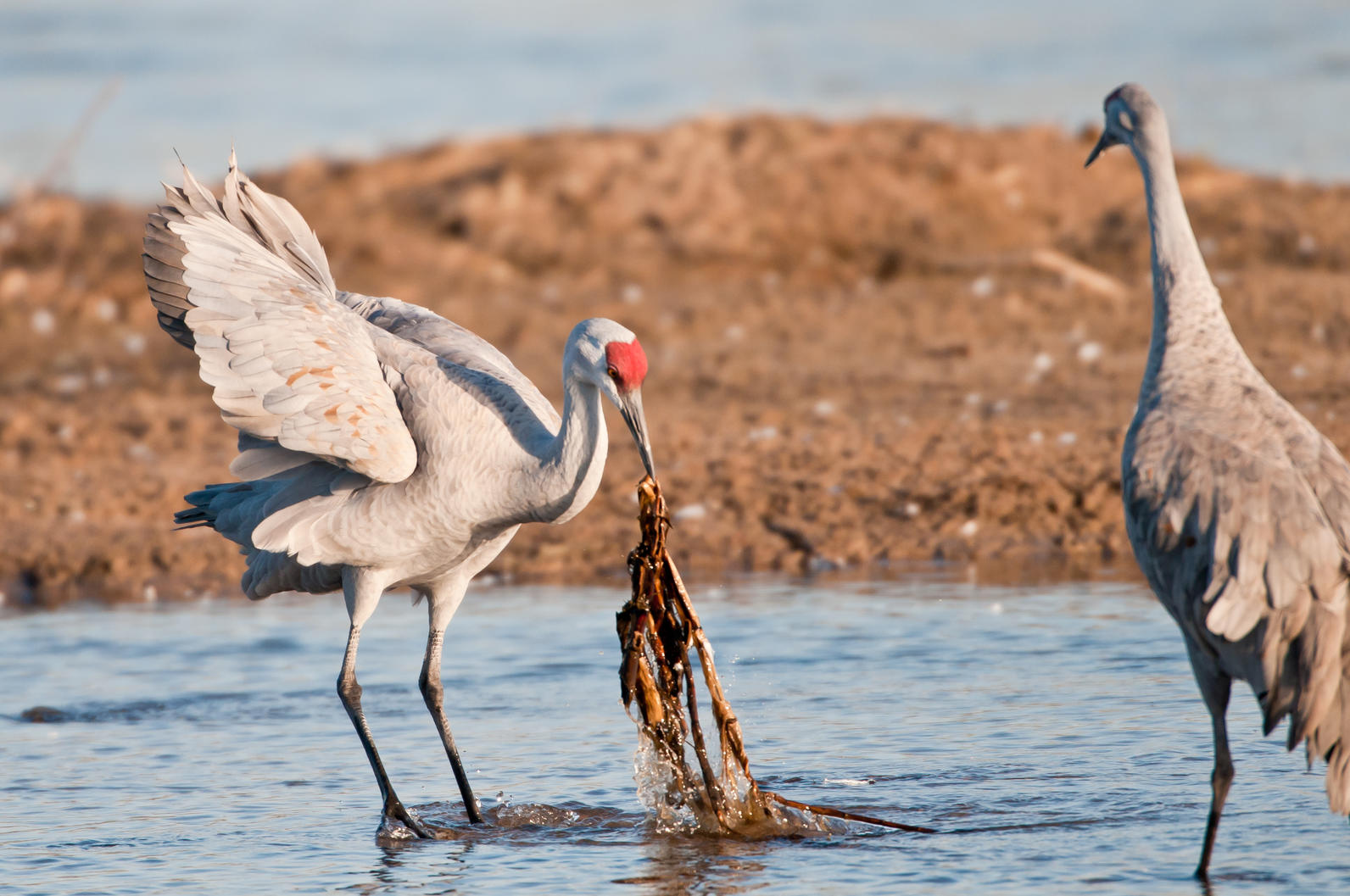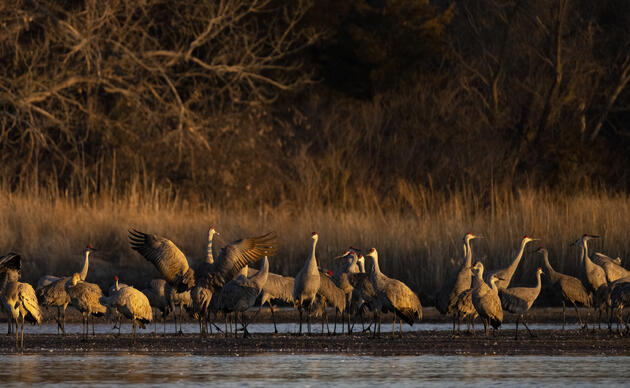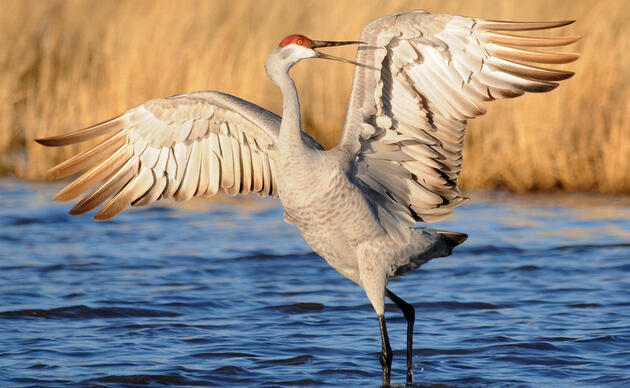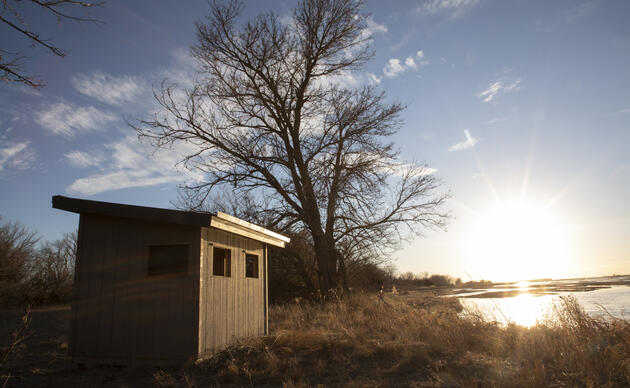Sandhill Crane Facts

Cranes are among the oldest living birds on the planet. A Crowned Crane fossil, a close relative of the Sandhill Crane, was found in the Ashfall Fossil Beds in northeast Nebraska, estimated to be about 10 million years old. According to the Cornell Lab of Ornithology, the earliest unequivocal Sandhill Crane fossil, estimated to be 2.5 million years old, was unearthed in the Macasphalt Shell Pit in Florida. Migration between wintering grounds in the south and breeding grounds in the north has likely taken Sandhill Cranes across what is now Nebraska for many thousands, if not millions, of years. Thus, the link between Sandhill Cranes and the Platte River is believed to date to the river’s origins some 10,000 to 12,000 years ago, following the end of the last ice age.
Below is information that will help to answer some basic questions regarding Sandhill Cranes and cranes in general.
Height: 3 to 4 feet
Weight: 6 to 12 pounds
Wingspan: 6 to 7 feet
Lifespan: 20 to 40 years
Diet: Cranes are omnivorous and their diet varies depending on the season and where they are at. The cranes that visit the Platte River valley feed primarily on waste grain left in corn fields, making up 90% of their diet while here. The other 10% comes from plant and animal foods found in wet meadows adjacent to the river. Seeds, fleshy tubers of plants, grubs, earth worms, snails, amphibians, small reptiles and small rodents are all fair game.
Color: Adult is gray with a red crown (bald patch of skin); juvenile is browner overall and has a feathered crown.
Subspecies: There are at least five subspecies of Sandhill Cranes. Migratory subspecies include the lesser, greater, and according to some, the Canadian Sandhill Crane. Non-migratory subspecies are the Florida, Mississippi and Cuban Sandhill Crane.
Flight speed & distance: 25 - 35 mph; cranes typically travel 200 - 300 miles in a day, but can reach 500 miles with a good tail wind.
Nesting: For migratory populations, nesting begins early April to late May. Non-migratory populations begin in December to early March. Nests are usually low mounds of vegetation located in wetlands, but are occasionally located in uplands. The female typically lays two eggs, with incubation lasting 29 - 32 days.
Status: Stable to increasing, except for the isolated populations in Mississippi and Cuba. The total for all subspecies numbers over 1 million, with Lesser Sandhill Cranes being the most abundant.
Sandhill Cranes and the Platte River
Sandhill Cranes have been found as far north as Alaska and Eastern Siberia. In order to reach these destinations, cranes must build up enough energy to complete their long journey and to begin breeding. For the cranes, the Platte River Valley is the most important stopover on this migration. The river provides the perfect spot to rest, and the nearby farmlands and wet meadows offer an abundance of food. Without the energy gained along the Platte, cranes might arrive at their breeding grounds in a weakened condition -- where food may be limited until the spring growing season begins.
The Platte River region has a variety of habitats that support cranes. The most important is the Platte River itself. The river is very shallow and sandbars dot the channels. It is here the cranes rest at night, gaining protection from predators like coyotes.
In the morning, cranes shuffle up and down the river waiting for the sun to pop up over the horizon. As the sun rises, cranes head out to feed and loaf in the surrounding fields. During the day, cranes "dance" to relieve the stress of migration and strengthen pair bonds. Cranes are very "social" birds and in the evening, congregate in wet meadows before heading back to the river for the night.
Flight and Function
Cranes are opportunistic fliers, relying on thermals and tail winds to carry them along. Thermals are rising columns of warm air and when southerly winds start to blow in late March and early April along the Platte, you will see cranes testing them for flight conditions. Cranes ride thermals so efficiently that they have been seen flying over Mt. Everest (~28,000 feet).
Their bills and feet are important tools. A crane's bill is very sharp and sturdy, useful when probing frozen soil. The edges are serrated to grasp slippery food like worms and snakes. Not only is it used for preening, it is also used as a weapon.
The feet and legs work in conjunction with the beak. The foot has three long toes with claws on the end. These claws are very sharp and can be used for scratching in dirt to find food and for protection. When a crane is threatened, it will use its wings to maintain its balance and then jump up and strike at the attacker with its feet.
How do they do that?
Do you ever wonder how cranes stay warm while standing for hours in near-freezing water? They can reduce the amount of blood that has to be warmed by constricting blood vessels in their feet. Also, the arteries and vessels in their legs are right next to each other so the colder blood is warmed before it reaches the body.
How you can help, right now
Book A Tour
Tour reservations open online on Wednesday, January 8, 2026, at 9:00 am CST. One of the greatest wildlife spectacles in North America, this gathering of cranes is the largest in the world.
Crane Season Programs and Events
This year for crane season, you can now book special events and programs in addition to your guided viewing experience.
Crane Season Information
Plan your visit. Whether you’re interested in programming, photography, or a guided tour, there’s something for everyone.



